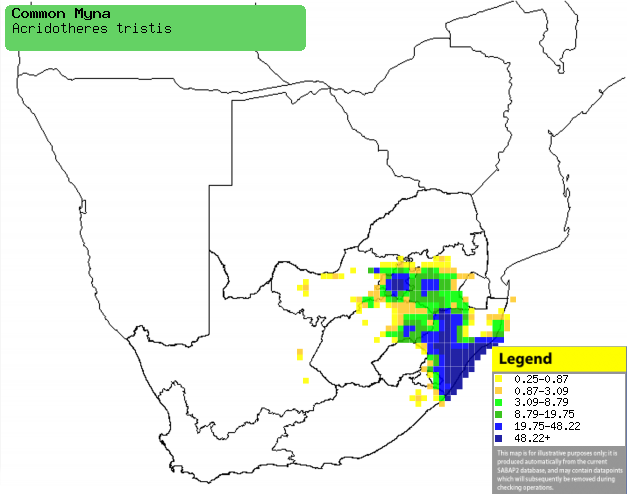|
Acridotheres tristis (Common
myna, Indian Myna)
Indiese spreeu [Afrikaans]; Treurmaina [Dutch]; Martin
triste [French]; Hirtenmaina [German]; Mainato [Portuguese]
Life
> Eukaryotes >
Opisthokonta
> Metazoa (animals) >
Bilateria >
Deuterostomia > Chordata >
Craniata > Vertebrata (vertebrates) > Gnathostomata (jawed
vertebrates) > Teleostomi (teleost fish) > Osteichthyes (bony fish) > Class:
Sarcopterygii (lobe-finned
fish) > Stegocephalia (terrestrial
vertebrates) > Tetrapoda
(four-legged vertebrates) > Reptiliomorpha > Amniota >
Reptilia (reptiles) >
Romeriida > Diapsida > Archosauromorpha > Archosauria >
Dinosauria
(dinosaurs) > Saurischia > Theropoda (bipedal predatory dinosaurs) >
Coelurosauria > Maniraptora > Aves
(birds) > Order: Passeriformes
> Family: Sturnidae
Distribution and habitat
Originally from India, central and southern Asia, it was
introduced to many islands in the Pacific and Atlantic, Australia, New Zealand,
Hong Kong, Brunei, Sumatra and South Africa. Here it is locally abundant in
KwaZulu-Natal, Mpumalanga and the eastern Free State, marginally extending into
the North-West Province and the Eastern Cape. It generally prefers urban areas
and farms in the immediate vicinity of buildings and other structures.
|
 |
|
Distribution of Common myna in southern Africa,
based on statistical smoothing of the records from first SA Bird Atlas
Project (©
Animal Demography unit, University of
Cape Town; smoothing by Birgit Erni and Francesca Little). Colours range
from dark blue (most common) through to yellow (least common).
See here for the latest distribution
from the SABAP2. |
Brood parasites
It has been recorded as host of the
Great spotted cuckoo.
Food
It mainly eats a invertebrates, fruit and seeds, doing most
of its foraging on the ground, briskly walking around and probing the soil. The following food items have been recorded
in its diet:
- Invertebrates
- Plants
- fruit
- figs
- dates
- pears
- grapes
- guavas
- seeds
- nectar
- Aloe
- Erythrina (Coral-tree)
- Human food scraps
Breeding
- The nest is built by both sexes, consisting of an untidy structure made of
grass, twigs, hair and man-made materials, such as paper, cloth, string and
plastic pieces. It is typically placed in a building, more rarely in a
free-standing tree or a cavity in a branch.
- Egg-laying season is year-round, peaking from September-January.
- It lays 2-6 eggs, which are incubated by both sexes for about 13-18
days.
- The chicks are fed by both parents, leaving the nest after about 22-35
days, becoming fully independent several weeks later.
Threats
Unprotected alien in southern Africa, although thankfully
it has had no significant impact on rural and natural habitats.
References
-
Hockey PAR, Dean WRJ and Ryan PG 2005. Roberts
- Birds of southern Africa, VIIth ed. The Trustees of the John Voelcker
Bird Book Fund, Cape Town.
|
